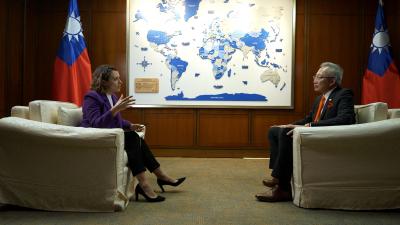Members of the legislature’s Transportation Committee yesterday accused the National Communications Commission (NCC) of dragging its feet in pushing the development of 4G wireless technology.
Asked to give a special report on the nation’s policy on 4G technology, commission Chairperson Su Herng (蘇蘅) said rearranging the bandwidth spectrum was the key factor affecting the issuance of operational licenses for 4G services.
She said the commission had planned to reorganize the use of several radio bands, including 700 megahertz (MHz), 900MHz, 1,800MHz and 2,600MHz.
However, those radio bands are all currently in use and it would take time to reassign them, she said, adding that the 700MHz band was being used by the military.
The Ministry of National Defense has agreed to relocate to a different bandwidth after negotiating with the Ministry of Transportation and Communications (MOTC), she said.
Based on the commission’s report, the Executive Yuan plans to launch bids for 4G licenses in 2015 and estimates that the technology could become commercially available in 2017.
The report also showed that telecom carriers worldwide mainly provide advanced wireless service through the Long Term Evolution (LTE) or WiMAX technologies, which are considered by many as quasi-4G services. Of the two, LTE technology currently dominates the market.
Taiwan, on the other hand, adopted WiMAX technology and provides commercial services utilizing the technology.
The International Telecommunication Union (ITU), the UN agency responsible for information and communication technologies, has set speed requirements for 4G services at 100 megabytes (MB) per second for high-mobility communication and 1GB per second for low-mobility communication.
At present, no LTE service provider in the world fulfills those requirements. People in the telecom sector refer to the existing LTE technology as “3.9G.”
Nonetheless, Chinese Nationalist Party (KMT) Legislator Lo Shu-lei (羅淑蕾) said the nation had fallen behind other Asian countries in terms of the development of LTE technology, adding that LTE services have already appeared in Singapore, Hong Kong and South Korea.
“Taiwan has no apparent competitiveness in this field and yet the NCC keeps focusing on fining TV programs for being too violent,” Lo said.
In response, Su said the commission has been negotiating with the MOTC and both thought there could be some flexibility in the timeline set by the Executive Yuan.
Su also said that South Korea could quickly develop LTE services because of a well-designed plan from the government and cooperation from the private sector.
“We need to consider 4G from various factors and cannot make leaps,” she said. “We need to take one step at a time.”
When asked which technology the commission would adopt, Su said it would make a decision after the ITU announces the technical requirements for 4G services next year.

“China is preparing to invade Taiwan,” Deputy Minister of Foreign Affairs Francois Wu (吳志中) said in an exclusive interview with British media channel Sky News for a special report titled, “Is Taiwan ready for a Chinese invasion?” the Ministry of Foreign Affairs said today in a statement. The 25-minute-long special report by Helen Ann-Smith released yesterday saw Sky News travel to Penghu, Taoyuan and Taipei to discuss the possibility of a Chinese invasion and how Taiwan is preparing for an attack. The film observed emergency response drills, interviewed baseball fans at the Taipei Dome on their views of US President

The Central Weather Administration (CWA) today issued a "tsunami watch" alert after a magnitude 8.7 earthquake struck off the Kamchatka Peninsula in northeastern Russia earlier in the morning. The quake struck off the east coast of the Kamchatka Peninsula at 7:25am (Taiwan time) at a depth of about 19km, the CWA said, citing figures from the Pacific Tsunami Warning Center. The CWA's Seismological Center said preliminary assessments indicate that a tsunami could reach Taiwan's coastal areas by 1:18pm today. The CWA urged residents along the coast to stay alert and take necessary precautions as waves as high as 1m could hit the southeastern

The National Museum of Taiwan Literature is next month to hold an exhibition in Osaka, Japan, showcasing the rich and unique history of Taiwanese folklore and literature. The exhibition, which is to run from Aug. 10 to Aug. 20 at the city’s Central Public Hall, is part of the “We Taiwan” at Expo 2025 series, highlighting Taiwan’s cultural ties with the international community, National Museum of Taiwan Literature director Chen Ying-fang (陳瑩芳) said. Folklore and literature, among Taiwan’s richest cultural heritages, naturally deserve a central place in the global dialogue, Chen said. Taiwan’s folklore would be immediately apparent at the entrance of the

ECONOMIC BENEFITS: The imports from Belize would replace those from Honduras, whose shrimp exports have dropped 67 percent since cutting ties in 2023 Maintaining ties with Taiwan has economic benefits, Ministry of Foreign Affairs officials said yesterday, citing the approval of frozen whiteleg shrimp imports from Belize by the Food and Drug Administration (FDA) as an example. The FDA on Wednesday approved the tariff-free imports from Belize after the whiteleg shrimp passed the Systematic Inspection of Imported Food, which would continue to boost mutual trade, the ministry said. Taiwan’s annual consumption of whiteleg shrimps stands at 30,000 tonnes, far exceeding domestic production, the ministry said. Taiwan used to fill the gap by importing shrimps from Honduras, but purchases slumped after Tegucigalpa severed diplomatic ties with Taiwan